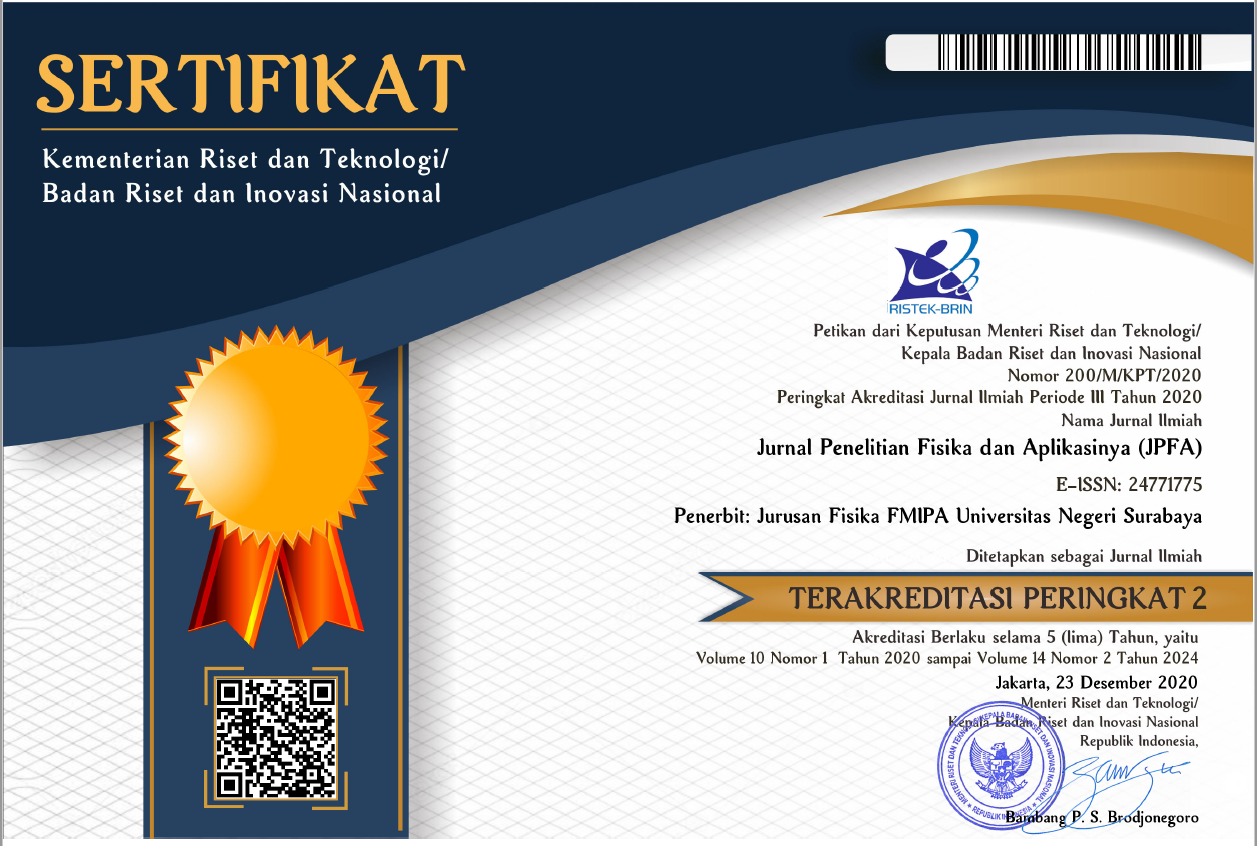Exploration of Seasonal Dynamics of Tropical Indo-Pacific Ocean during Dry, Wet and Neutral Years in Indonesia using Composite Method
DOI:
https://doi.org/10.26740/jpfa.v14n1.p67-83Keywords:
Indian Ocean Dipole (IOD), El Niño-Southern Oscillation (ENSO), Composite Method, Ocean-Atmosphere DynamicsAbstract
Applying rainfall data for each month from Princeton University from January 1948 to December 2016, the impact of the Pacific El Niño-Southern Oscillation (ENSO) and the Indian Ocean Dipole (IOD), which is focused in the Indian Ocean, on rainfall in Indonesia was examined. IOD occurrences are significantly correlated with rainfall, as seen by the simultaneous association of seasonal rainfall anomalies during the peak of the rainy season (NDJ) in Indonesia's dry, wet, and neutral years, as well as other climatic indices in both climates. Rainfall has occurred in parts of South Sumatra, Java, South Kalimantan, Nusa Tenggara, Sulawesi, and East Papua. Meanwhile, ENSO events significantly correlate with rainfall in the southern regions of Sumatra, Java, Kalimantan, Sulawesi, and Papua. El Niño is associated with low sea surface temperature anomalies in the Indonesian Sea and southeast Indian Ocean. The low SST anomaly lowers the mean sea surface level (MSL). It reduces the amount of water vapor in the atmosphere, suppressing atmospheric convection in Indonesia and leading to a very sharp decrease in rainfall. Based on the forecasting and exploration of rainfall patterns in Indonesia described in this study, this research can be used as a reference for the government to prepare preventive measures against extreme global climate change events and to predict hydrometeorological disasters in disaster-prone areas.
References
Lestari DO, Sutriyono E, Sabaruddin S, and Iskandar I. Respective Influences of Indian Ocean Dipole and El Niño-Southern Oscillation on Indonesian Precipitation. Journal of Mathematical and Fundamental Sciences. 2018; 50(3): 257–272. DOI: https://doi.org/10.5614/j.math.fund.sci.2018.50.3.3.
Irfan M, Safrina E, Koriyanti E, Saleh K, Kurniawaty N, and Iskandar I. What are The Dynamics of Hydrometeorological Parameters on Peatlands During The 2019 Extreme Dry Season? Journal of Physics: Conference Series. 2022; 2165(1): 012003. DOI: https://doi.org/10.1088/1742-6596/2165/1/012003.
Iskandar I, Sari QW, Setiabudiday D, Yustian I, and Monger B. The Distribution and Variability of Chlorophyll-A Bloom in The Southeastern Tropical Indian Ocean Using Empirical Orthogonal Function Analysis. Biodiversitas. 2017; 18(4): 1546-1555. DOI: https://doi.org/10.13057/biodiv/d180433.
Ariska M, Akhsan H, and Muslim M. Impact Profile of Enso and Dipole Mode on Rainfall As Anticipation of Hydrometeorological Disasters in the Province of South Sumatra. Spektra: Jurnal Fisika dan Aplikasinya. 2022; 7(3): 127-140. DOI: https://doi.org/10.21009/spektra.073.02.
Chang CP, Wang Z, Ju J, Li T. On The Relationship Between Western Maritime Continent Monsoon Rainfall and ENSO During Northern Winter. Journal of Climate. 2004; 17(3): 665-672. doi: https://doi.org/10.1175/1520-0442(2004)017<0665:OTRBWM>2.0.CO;2.
Iskandar I, Tozuka T, Masumoto Y, and Yamagata T. Impact of Indian Ocean Dipole on Intraseasonal Zonal Currents at 90°E On the Equator As Revealed by Self-Organizing Map. Geophysical Research Letters. 2008; 35(14): 1-5. DOI: https://doi.org/10.1029/2008GL033468.
Gibson PB, Perkins-Kirkpatrick SE, Uotila P, Pepler AS, and Alexander LV. On The Use of Self-Organizing Maps for Studying Climate Extremes. Journal of Geophysical Research: Atmosphere. 2017; 122(7): 3891-3903. DOI: https://doi.org/10.1002/2016JD026256.
Agusta AR, Arman Y, and Ihwan A. Pemodelan Curah Hujan Bulanan Di Kabupaten Sintang Menggunakan Metode Monte Carlo dengan Algoritma Metropolis. Positron: Berkala Ilmiah Fisika. 2013; 3(2): 32–34. DOI: https://doi.org/10.26418/positron.v3i2.5126.
Ghiffari A, Ramayanti I, Anwar C, Hasyim H, Legiran L, Iskandar I, and Kamaluddin MT. The Mapping of High-Risk Districts with Economic, Physical, and Environment-Vulnerable Factors to COVID-19 Infection in Palembang City. Proceedings of the 3rd Sriwijaya International Conference on Environmental Issues, SRICOENV 2022, Palembang, South Sumatera, Indonesia. 2023; 2019: 5–11. DOI: https://doi.org/10.4108/eai.5-10-2022.2328337.
Jun-Ichi H, et al. Interannual Rainfall Variability Over Northwestern Jawa and Its Relation to The Indian Ocean Dipole and El Niño-Southern Oscillation Events. Scientific Online Letters On The Atmosphere. 2012; 8(1): 69-72. doi: https://doi.org/10.2151/sola.2012-018.
Hendon HH. Indonesian Rainfall Variability: Impacts of ENSO and Local Air-Sea Interaction. Journal of Climate. 2003; 16(11): 1775-1790. DOI: https://doi.org/10.1175/1520-0442(2003)016<1775:IRVIOE>2.0.CO;2.
Kurniawati N, Lestari DO, Fauziyah, Setiabudidaya D, and Iskandar I. Variation of Thermodynamic Layers Over the South Coastal Java Region (SJCR) and Their Influences on Nutrient Abundance. Journal of Physics: Conference Series. 2020; 1568(1): 012029. DOI: https://doi.org/10.1088/1742-6596/1568/1/012029.
Landsea CW and Knaff JA. How Much Skill Was There in Forecasting The Very Strong 1997-98 El Niño? Bulletin of the American Meteorological Society. 2000; 81(9): 2107-2119. DOI: https://doi.org/10.1175/1520-0477(2000)081<2107:HMSWTI>2.3.CO;2.
Murazaki K, Kurihara K, and Sasaki H. Dynamical Downscaling of JRA-25 Precipitation Over Japan Using the MRI-Regional Climate Model. Scientific Online Letters on the Atmosphere. 2010; 6(1): 141-144. DOI: https://doi.org/10.2151/sola.2010-036.
Irfan M and Iskandar I. The Impact of Positive IOD and La Niña on the Dynamics of Hydro-Climatological Parameters on Peatland. International Journal of GEOMATE. 2022; 23(97): 115-122. DOI: https://doi.org/10.21660/2022.97.3307.
Iskandar I, et al. Extreme Positive Indian Ocean Dipole in 2019 and Its Impact on Indonesia. Sustainability. 2022; 14(22): 15155. DOI: https://doi.org/10.3390/su142215155.
Hamada JI, Yamanaka MD, Matsumoto J, Fukao S, Winarso PA, and Sribimawati T. Spatial and Temporal Variations of The Rainy Season Over Indonesia and Their Link to ENSO. Journal of the Meteorological Society of Japan. 2002; 80(2): 285-310. DOI: https://doi.org/10.2151/jmsj.80.285.
Irfan M, Safrina S, Awaluddin, Sulaiman A, Virgo F, and Iskandar I. Analysis of Rainfall and Temperature Dynamics in Peatlands During 2018-2021 Climate Change. International Journal of GEOMATE. 2022; 23(99): 41-47. DOI: https://doi.org/10.21660/2022.99.3562.
Ariska M, Putriyani FS, Akhsan H, and Irfan M. Trend of Rainfall Pattern in Palembang for 20 Years and Link to El Niño Southern Oscillation (ENSO). Jurnal Ilmiah Pendidikan Fisika Al Biruni. 2023; 12(1): 67-75. DOI: https://doi.org/10.24042/jipfalbiruni.v12i1.15525.
Horii T, Siswanto E, Iskandar I, Ueki I, and Ando K. Can Coastal Upwelling Trigger a Climate Mode? A Study on Intraseasonal-Scale Coastal Upwelling Off Java and the Indian Ocean Dipole. Geophysical Research Letters. 2022; 49(15): e2022GL098733. doi: https://doi.org/10.1029/2022GL098733.
Lestari DO, Sutriyono E, Kadir S, and Iskandar I. Impact of 2016 Weak La Niña Modoki Event Over the Indonesian Region. International Journal of GEOMATE. 2019; 17(61): 156-162. DOI: https://doi.org/10.21660/2019.61.8256.
Haylock M and McBride J. Spatial Coherence and Predictability of Indonesian Wet Season Rainfall. Journal of Climate. 2001; 14(18): 3882-3887. DOI: https://doi.org/10.1175/1520-0442(2001)014<3882:SCAPOI>2.0.CO;2.
Akhsan H, Romadoni M, and Ariska M. Prediction of Extreme Temperature in South Sumatra and Its Applications at The End of The 21st Century. Jurnal Penelitian Pendidikan IPA. 2022; 8(2): 925-931. DOI: https://doi.org/10.29303/jppipa.v8i2.1363.
Ariska M, Darmawan A, Akhsan H, Supari S, Irfan M, Iskandar I. Pemodelan Numerik Hubungan Pola Curah Hujan Wilayah Equatorial di Pulau Sumatera Terhadap Fenomena ENSO dan IOD. Jurnal Teori dan Aplikasi Fisika. 2023; 11(2): 95-106. DOI: https://doi.org/10.23960/2fjtaf.v11i2.6593.
Suhadi, Supari, Iskandar I, Irfan M, and Akhsan H. Drought Assessment in Aceh and North Sumatra Using Effective Drought Index. Science and Technology Indonesia. 2023; 8(2): 259-264. DOI: https://doi.org/10.26554/sti.2023.8.2.259-264.
Ariska M, Suhadi S, and Herlambang DK. Empirical Orthogonal Function (EOF) Analysis Based on Google Colab on Sea Surface Temperature (SST) Dataset in Indonesian Waters. Indonesian Physical Review. 2022; 6(1):20-32. DOI: https://doi.org/10.29303/ipr.v6i1.187.
Ariska M, Akhsan H, Muslim M. Utilization of Physics Computation Based on Maple in Determining the Dynamics of Tippe Top. Journal of Physics: Conference Series. 2019; 1166(1): 012009. DOI: https://doi.org/10.1088/1742-6596/1166/1/012009.
Ye Z and Li Z. Spatiotemporal Variability and Trends of Extreme Precipitation in the Huaihe River Basin, A Climatic Transitional Zone in East China. Advances in Meteorology. 2017; 2017: 3197435. DOI: https://doi.org/10.1155/2017/3197435.
Kumar S, Silva Y, Moya-Álvarez AS, and Martínez-Castro D. Seasonal and Regional Differences in Extreme Rainfall Events and Their Contribution to The World’s Precipitation: GPM Observations. Advances in Meteorology. 2019; 2019: 4631609. DOI: https://doi.org/10.1155/2019/4631609.
McKee TB and Thomas JD. Analysis of Standardized Precipitation Index (SPI) Data for Drought Assessment. Water (Switzerland). 1993; 26(2): 1-72.
Brandes EE, Zhang G, and Vivekanandan J. Experiments in Rainfall Estimation with a Polarimetric Radar in A Subtropical Environment. Journal of Applied Meteorology. 2002; 41(6): 674-683. DOI: https://doi.org/10.1175/1520-0450(2002)041<0674:EIREWA>2.0.CO;2.
Zhan YJ, et al. Changes in Extreme Precipitation Events Over the Hindu Kush Himalayan Region During 1961–2012. Advances in Climate Change Research. 2017; 8(3): 166-175. DOI: https://doi.org/10.1016/j.accre.2017.08.002.
Bhatti AS, et al. Trend in extreme precipitation indices based on long term in situ precipitation records over Pakistan. Water (Switzerland). 2020; 12(3): 797. DOI: https://doi.org/10.3390/w12030797.
Aldrian E. Decreasing Trends in Annual Rainfalls Over Indonesia: A Threat for the National Water Resource? Jurnal Meteorologi dan Geofisika. 2007; 7(April): 40-49.
Yamanaka MD. Physical Climatology of Indonesian Maritime Continent: An Outline to Comprehend Observational Studies. Atmospheric Research. 2016; 178–179: 231-259. DOI: https://doi.org/10.1016/j.atmosres.2016.03.017.
Yamanaka MD. Equatorial Rainfall and Global Climate. ISQUAR. 2018; 3(March) :3-6.
Annamalai H, Kida S, and Hafner J. Potential Impact of the Tropical Indian Ocean-Indonesian Seas On El Niño Characteristics. Journal of Climate. 2010; 23(14): 3933-3952. doi: https://doi.org/10.1175/2010JCLI3396.1.
Katsumata M, Mori S, Hamada JI, Hattori M, Syamsudin F, and Yamanaka MD. Diurnal Cycle Over a Coastal Area of the Maritime Continent as Derived by Special Networked Soundings Over Jakarta During HARIMAU2010. Progress in Earth and Planetary Science. 2018; 5(1): 64. DOI: https://doi.org/10.1186/s40645-018-0216-3.
Kajita R, Yamanaka MD, and Kozan O. Reconstruction of Rainfall Records at 24 Observation Stations in Sumatera, Colonial Indonesia, from 1879–1900. Journal of Hydrometeorology. 2022; 23(4): 1627-1643. DOI: https://doi.org/10.1175/jhm-d-20-0245.1.
Tanaka H and Yamanaka MD. Atmospheric by the Circulation Mesoscale in the Lower Stratosphere Breakdown Induced Mountain Wave. Journal of Meteorological Society of Japan. 1985; 63(6): 1047-1054. Available from: https://www.jstage.jst.go.jp/article/jmsj1965/63/6/63_6_1047/_pdf.
Downloads
Additional Files
Published
How to Cite
Issue
Section
License
Copyright (c) 2024 Jurnal Penelitian Fisika dan Aplikasinya (JPFA)

This work is licensed under a Creative Commons Attribution-NonCommercial 4.0 International License.
Author(s) who wish to publish with this journal should agree to the following terms:
- Author(s) retain copyright and grant the journal right of first publication with the work simultaneously licensed under a Creative Commons Attribution-Non Commercial 4.0 License (CC BY-NC) that allows others to share the work with an acknowledgement of the work's authorship and initial publication in this journal for noncommercial purposes.
- Author(s) are able to enter into separate, additional contractual arrangements for the non-exclusive distribution of the journal's published version of the work (e.g., post it to an institutional repository or publish it in a book), with an acknowledgement of its initial publication in this journal.
The publisher publish and distribute the Article with the copyright notice to the JPFA with the article license CC-BY-NC 4.0.
 Abstract views: 396
,
Abstract views: 396
, PDF Downloads: 237
,
PDF Downloads: 237
, PDF Downloads: 0
PDF Downloads: 0








